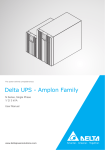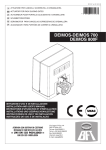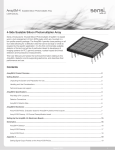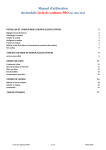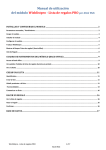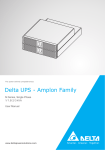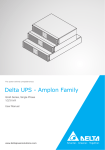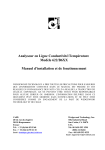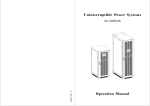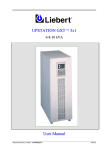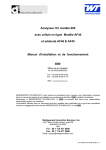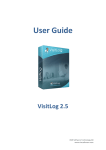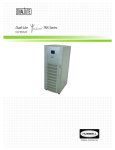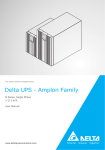Download the user manual
Transcript
User manual CellD APS 1500A-230-3 SSW 5012227500_00 Table of contents 1 2 3 4 About this document ........................................................................................... 3 1.1 Preparing for the installation .................................................................... 3 1.1.1 Document content ...................................................................... 3 1.1.2 Contents of packing ................................................................... 3 1.1.3 Before you begin ........................................................................ 4 1.1.4 Unpacking the system ............................................................... 4 Safety instructions .............................................................................................. 5 2.1 About legal and safety information ........................................................... 5 2.2 Legal statements ...................................................................................... 5 2.2.1 Statement of compliance ........................................................... 5 2.2.2 Limitations .................................................................................. 5 2.2.3 Third party devices .................................................................... 6 2.3 Safety instructions .................................................................................... 6 2.3.1 General instructions ................................................................... 6 2.3.2 Specific instructions ................................................................... 8 Installation and commissioning .......................................................................... 9 3.1 CellD APS 1500A-230-3 SSW system configuration ............................... 9 3.2 Installation .............................................................................................. 10 3.2.1 Mechanical assembly .............................................................. 10 3.2.2 Cabling ..................................................................................... 11 3.3 Commissioning ....................................................................................... 13 3.3.1 Starting up the system ............................................................. 13 3.3.2 Switching off the system .......................................................... 14 Troubleshooting ................................................................................................ 15 4.1 About this document .............................................................................. 15 4.2 Standard troubleshooting procedure ...................................................... 15 4.3 System status indications ....................................................................... 15 4.3.1 Static switch module LED indications ...................................... 15 4.3.2 Alarms and fault conditions in static switch module ................ 16 4.3.2.1 Inv. In Use LED flashing ........................................... 16 4.3.2.2 Mains In Use LED flashing ....................................... 16 4.3.2.3 Inv. Failure LED lit .................................................... 16 4.3.2.4 Mains failure LED lit ................................................. 16 4.3.2.5 Fault LED continuously lit ......................................... 16 4.3.2.6 Overload LED lit ....................................................... 17 4.3.2.7 Fault LED flashing with Inv.found LED ..................... 17 4.3.2.8 Fault LED flashing with Inv.failure LED .................... 17 4.3.2.9 Fault LED flashing in opposite phase with Inv.failure LED ........................................................................... 17 4.3.2.10 Fault LED flashing alone .......................................... 17 4.3.3 Inverter module LED indications .............................................. 18 4.3.4 Alarms and fault conditions in inverter module ........................ 18 4.3.4.1 Fault/overload LED continuously lit .......................... 18 4.3.4.2 Parallel LED flashing alone ...................................... 19 4.3.4.3 Input LED flashing alone .......................................... 19 4.3.4.4 Fault LED flashing with Input LED............................ 19 4.3.4.5 Fault LED flashing with Parallel LED ....................... 19 4.3.4.6 Fault LED flashing with Output LED ......................... 19 4.3.4.7 Fault LED flashing with Output and Parallel LEDs ... 19 4.3.4.8 Fault LED flashing alone .......................................... 19 4.4 User programmable parameters ............................................................ 20 4.4.1 User programmable parameters in static switch ..................... 20 4.4.1.1 Default supply ........................................................... 21 4.4.1.2 Input limits ................................................................ 21 4.4.1.3 Temperature ............................................................. 23 CellD APS 1500A-230-3 SSW Table of contents 4.4.2 5 User programmable parameters in inverter module ................ 24 4.4.2.1 Input voltage ............................................................. 24 4.4.2.2 Output voltage .......................................................... 26 4.4.2.3 Temperature ............................................................. 27 4.5 Contacting Delta customer service ........................................................ 28 Technical specifications, CellD APS 1500A-230-3 SSW ................................. 29 CellD APS 1500A-230-3 SSW Table of contents 1 About this document 1.1 Preparing for the installation 1.1.1 Document content This document contains the following sections: • • • • • 1.1.2 Safety instructions Product description, Delta outdoor cabinet (only with outdoor cabinets) Installation and commissioning Troubleshooting Appendix Contents of packing The package contains the following items: • System • Documents: user manual, CD “Extras”, circuit diagram(s), component layout(s) (CD and appendices on the manual pocket) Figure 1. User manual and CD • Possible inverters • Possible cables (DC supply cables, AC supply cables) CellD APS 1500A-230-3 SSW About this document 3 1.1.3 1.1.4 4 Before you begin Step 1 Ensure that you have all the equipment needed to make a proper installation of the system. Step 2 Also ensure that grounding terminals, DC and AC distributions are properly available. Step 3 Take care that the regulations of IEC 60364 and CENELEC HD384 concerning installation and assembling of telecommunication and electrical equipment have been noticed. The local regulations and special instructions must also be noticed during the work. When choosing the place of the installation, please notice that the cooling air must flow without restrictions through the ventilation holes. The system must have enough space in front of it for operation and service functions. Notice the direction of the cabling and the required space of the other equipment. Unpacking the system Step 1 Check that the received cargo is according to the packing list. Step 2 Ensure that the rack and the equipment are not damaged during transportation. CellD APS 1500A-230-3 SSW About this document 2 Safety instructions 2.1 About legal and safety information Please read all safety and legal information given provided here before working with any Delta products. Ignoring these instructions may result in damage to the equipment, health hazards, or loss of life. These safety instructions are an extension of any national laws governing health and safety at work and the applicable standards, as well as any regulations of the statutory authorities. Installation shall only be performed by trained persons familiar with the local installation regulations. The local installation regulations must always be followed (covering installations in the building and main AC distribution panels). It is also necessary to follow the instructions provided in the system user manual for installation, commissioning, operation and maintenance. 2.2 Legal statements 2.2.1 Statement of compliance Please see the relevant product fact sheet for information. 2.2.2 Limitations The equipment is mainly intended for telecommunications purposes only. The equipment is not intended for use in applications in which the failure of the equipment could lead to death, personal injury, or severe physical or environmental damage. Delta is not responsible for any danger or damage resulting from incorrect installation, maintenance, operation or usage of the equipment, use beyond its intended purpose, failure to observe stated instructions, and/or failure to observe the applicable safety regulations. Delta is only responsible for components and services provided by Delta. Third party components and/or services, such as batteries, repair and/or maintenance used in and/or conducted for the equipment, are not the responsibility of Delta. Furthermore, Delta is not responsible for any malfunction or danger of, and/or damage to/resulted from the equipment caused by such third party components and/or services. Unauthorised modifications to the equipment may result in incorrect operation and/or performance. The operator is responsible for the consequences of any modification in the hardware configuration that is made without an agreement with the manufacturer or authorised representative. CellD APS 1500A-230-3 SSW Safety instructions 5 Installation, operation and maintenance of the equipment should only be performed by suitably qualified personnel with appropriate training. The operator is responsible for ensuring that personnel working with the equipment are provided with appropriate operation and safety training. The operator is responsible for ensuring that the location of the system is treated as an electrical equipment room. These rooms must have appropriate air-conditioning and restricted access. The operator is also responsible for ensuring that the system rack doors are securely locked and not accessible to unauthorised persons. The equipment must be installed on an incombustible base, e.g. on a concrete floor. If the power supply to the system is not fitted with a disconnecting switch or equivalent device, the operator is responsible for fitting an appropriate disconnection switch conforming to the relevant regulations. 2.2.3 Third party devices Delta is not responsible for devices, such as batteries that are not supplied by Delta. Delta is not responsible for any danger or damage resulting from devices not supplied by Delta. 2.3 Safety instructions Warnings, cautions and notes are used to identify important information. They are classified as follows: Warning! A warning means that injury or death is possible if the information or instructions are not obeyed. Caution! A caution means that damage to equipment is possible if the information or instructions are not obeyed. Note! Notes are additional information which may be useful to the operator. 2.3.1 General instructions Warning! Hazardous voltages are present within the equipment when a source of electrical power is applied. There is the risk of electrical shock from the main power supply and/or batteries. When working on equipment with power applied, supervision of personnel is required. The supervisor must be capable of providing first aid in the event of electrical shock. Provision of an emergency switch or disconnection strap is not sufficient protection. 6 CellD APS 1500A-230-3 SSW Safety instructions There is increased risk of accidents and electrical hazards when working on compact equipment due to the close proximity of components. Operation of compact equipment requires extra attention to safety. Warning! Protective shields and other safety devices provided with the equipment must be in place when the equipment is operated. The power system may have dual energy supply. Hazardous voltages may be present at the main power connector and within the equipment for up to 10 seconds after disconnecting the power supply. The operator is responsible for securing the proper precautions for maintenance or service purposes. During installation and maintenance, protective shields may be temporarily removed. Use suitable insulated tools and appropriate protective clothing. Handle fuses only with tools provided for this purpose, for example, load-break switch handles. Adequate insulation from ground potential (earth) must be provided when working on the equipment. Warning! High temperatures present. Localized areas of high temperature (> 70 °C) may occur within the rectifier/inverter/distributor rack. Take precautions against accidental burns. Warning! Moving parts Devices, such as rectifiers and environmental control for cabinets contain fans. These may also continue to rotate for some time after the power has been removed. Warning! Heavy equipment The weight of the equipment requires suitable safety considerations. Additional personnel or lifting equipment may be needed. Where required, the weight of equipment is stated on the front of the unit. Warning! Sharp edges Equipment racks may have sharp edges. We recommend you to wear gloves. Caution! Do not restrict air flow. Fit blank panels for empty rectifier slots to ensure correct air circulation inside the cabinet. Caution! Use only suitable measuring devices. Calibrate measuring devices regularly. CellD APS 1500A-230-3 SSW Safety instructions 7 2.3.2 Specific instructions Please observe all warning labels and notifications on the equipment. Additional warnings, cautions and notes specific to certain equipment and/or conditions are described in the context of the relevant instructions. Please read all documentation relevant to the given task. Where devices, such as batteries, that are not supplied by Delta are used, please read and observe all safety notices and instructions supplied by the appropriate manufacturer or supplier. 8 CellD APS 1500A-230-3 SSW Safety instructions 3 Installation and commissioning 3.1 CellD APS 1500A-230-3 SSW system configuration Figure 2. Inverter system CellD APS 1500A-230-3 SSW front view Figure 3. Inverter system CellD APS 1500A-230-3 SSW back view CellD APS 1500A-230-3 SSW Installation and commissioning 9 1. Grounding mounting point 11. 19” 1.5U shelf for inverter and 7.5 kVA static switch modules 2. DC supply plus connection 12. 19” 1.5U shelf for two inverter modules 3. DC supply minus connections 13. Plug-in inverter module 1.5 kVA 4. DC supply inverter pre-fuses 14. Plug-in static switch module 7.5 kVA 5. Optional AC Mains fuse and terminals 15. Standard 19” adjustable mounting brackets 6. Optional distribution socket 16. Optional slide rails 7. Optional RCCB for socket 17. Place for inverter module 8. AC distribution breakers 18. Remote alarm terminals 9. Optional manual by-pass switch 19. AC distribution PE-terminals 10. Inverter monitoring RS 232 20. Optional AC distribution N-terminals Note! The bracketed [ ] numbers in this instruction refer to the corresponding numbers in Figure 2, Figure 3, Figure 4 and Figure 5. 3.2 Installation 3.2.1 Mechanical assembly 10 Step 1 Prepare the system for 19” rack assembly by standard mounting brackets [15] or optional slide rails [16]. Mounting brackets have several possible mounting positions in depth dimension. The slide rails are mounted into front position. Step 2 Lift the unit into 19” cabinet. Fasten the mounting screws. When using slide rails, secure the assembly into the rack by fastening the inverter shelves into the rack. CellD APS 1500A-230-3 SSW Installation and commissioning Figure 4. The basic 19 inch mounting flanges can be on several depth positions Step 3 3.2.2 Remove the roof and any protective covers from the system unit in front of the distributions and connections. Cabling Warning! All circuit breakers must be in the OFF position and all fuses must be removed. Step 1 Connect the frame grounding [1] to the main grounding busbar. Positive DC supply terminals are already connected to ground via inverters. Figure 5. Grounding connection for main PE-cable CellD APS 1500A-230-3 SSW Installation and commissioning 11 Step 2 Connect the AC mains supply cables to the AC power terminals [5]. See Table 1 for information about the correct main power supply fuses and type of cables to use. Note! Use the wiring diagram, supplied with the installation documentation, to ensure the DC and optional AC power supplies have been correctly connected. Note! The AC supply connection of the static switch is always a 1-phase connection. The tables below show the recommended fuse size of connection and the minimum cable cross sections. AC- and DC-supply connections Mains fuse Cable cross section (minimum) AC mains supply for static switch 40A gL/gG 3 x 6 mm² DC supply separately for each inverter n * 40A n x 6 mm² DC supply common for max. 2 inverters 80A 1 x 16 mm² DC supply common for max. 3 inverters 120A 1 x 35 mm² DC supply common for max. 4 inverters 160A 1 x 50 mm² Table 1. AC and DC input cable and fuse size rule Note! The maximum cable size for the connectors on the neutral and PE -bus bars of the distribution MCB is 16 mm². Note! The DC supply of the system is positively grounded. Step 3 Connect the DC supply minus cable(s) into the DC supply common bus bar or separate pre-fuse for each inverter module. Step 4 Connect the remote alarm cables to the remote alarm terminals [18]. Note! Alarms are connected in normal operation so that the alarm circuit is closed (NC), and in case of registered fault the circuit is open (NO). 12 Step 5 Connect the load distribution cables to the PE-bus bar [19] and load breakers of the system. When the AC distribution is protected with 1P MCB’s the system has separate neutral (N- ) [20] and earth (PE-) bus bars [19]. Step 6 Connect the line wires directly to the connections of the AC distribution circuit breakers or fuses [8]. Step 7 Install all protective covers to the equipment. CellD APS 1500A-230-3 SSW Installation and commissioning 3.3 Commissioning 3.3.1 Starting up the system Taking the system into use is presented below step by step. Step 1 Check that all inverter module main switches are in the OFF position. Step 2 Plug in the inverter modules to the inverter shelves [14] of the system. The modules are secured with a lever on the front. Step 3 Plug in the optional static switch to the inverter shelves [14] of the system. The static switch is situated on the right-hand-side slot in the upper shelf. Note! One inverter shelf version has only two slots for inverter modules without option for static switch. The modules are secured with a lever on the front. Warning! Protective shields and other safety devices provided with the equipment must be in place when the equipment is operated. During installation and maintenance, protective shields may be temporarily removed. Suitable insulated tools and appropriate protective clothing must be used. Check that the connections are made according to the installation instructions and the wiring diagram. Step 4 Switch on the optional AC mains power supply to the system. Step 5 Switch on all the DC input breakers [4]. Step 6 Turn all DC INPUT rocker switches on inverter modules to the ON position. Operate the switches in min. 1s sequence in the preferred bus address order. When all parallel LED lights stop flashing the inverter system is ready for operation. Step 7 Press TWO AC-ON buttons simultaneously on separate inverter modules at least 1s to turn on the output voltage. The output LEDs turn on. Step 8 Turn the manual by-pass switch step-by-step to the AUTO position. That will start the static switch automatically. Note! Stay at the minimum 2s in the position SYNC for synchronizing the inverter system with AC mains. Step 9 Turn all required AC load breakers on. Step 10 Check the output load level from the LED bar indicator on the inverter modules. CellD APS 1500A-230-3 SSW Installation and commissioning 13 3.3.2 14 Switching off the system Step 1 Turn off the output of all inverters at the same time by pressing TWO AC-OFF buttons on the inverter modules at least 1s. Step 2 Inverters can be shut down totally by turning all DC input rocker switches to the OFF position. Step 3 The optional static switch can be turned off by shutting all AC inputs. Turn the manual by-pass switch step-by-step to the OFF position. CellD APS 1500A-230-3 SSW Installation and commissioning 4 Troubleshooting 4.1 About this document This document provides only basic information to assist in identifying and recovering from potential problems with Delta Energy Systems. The most accurate information can be found in the documents of the inverter module and static switch supplier. Refer to the User manual, DAC60000 inverters & DAC60000 dual inverters and User manual, BPU 69000 6kVA static switch & BPU 69000 dual 7.5kVA static switch & BPU 69000 dual 30kVA static switch for more information. 4.2 Standard troubleshooting procedure Troubleshooting is always initiated by an alarm. Alarms may be monitored remotely or locally. Relay alarms trigger LEDs locally, but can also be wired for remote monitoring. As a standard a Delta Energy Systems inverter system includes terminal blocks for alarm connections. Diagnostic for static switch module If the static switch recognizes a fault condition it indicates it by the front panel LEDs. In case of a fault the alarm can be reset by resolving the problem in the system. Refer to the User manual for more information. Diagnostic for inverter module If the inverter recognizes a fault condition it uses the front panel LEDs in indicating it to the user. In case of a fault the alarm can be reset by resolving the problem in the system. In case of an alarm on the inverter (refer the User manual) press shortly the ON button. If this procedure does not help, try shutting down the inverter by turning the Power On rocker switch to the OFF position, and then restart the inverter by turning the Power On rocker switch back to the ON position. Refer to the User manual for more information about alarms. 4.3 System status indications 4.3.1 Static switch module LED indications Overload: The inverter system is overloaded or would be overloaded if it was used to supply the load or the load current exceeds the maximum allowed output current of the bypass. Mains failure: Mains voltage or frequency is not in allowed limits. Use RemoteMonitor software for more accurate information. Mains in use: The output of the bypass is supplied from the mains. If the LED is continuously lit it is the default supply. If the LED flashes it indicates that it is the backup supply. CellD APS 1500A-230-3 SSW Troubleshooting 15 Synchronized: Inverter output voltage is synchronized to the mains voltage. Fault: Flashes when there is a fault in the system. Use RemoteMonitor software for more accurate information. If this LED is continuously lit the microprocessor of the bypass is not working. Try to press the Reset button in the bottom of the front panel. Inv. failure: Inverter output is off, inverter voltage or frequency is not in allowed limits or the communication between the bypass and the inverter is not working. Use RemoteMonitor software for more accurate information. Inv. in use: The output of the bypass is supplied from the inverter. If the LED is continuously lit it is the default supply. If the LED flashes it indicates that it is the backup supply. Inv. found: Bypass has found inverters connected to the control bus. If this LED flashes with the fault LED the communication bus is disconnected or there are other problems on the communication bus. 4.3.2 Alarms and fault conditions in static switch module 4.3.2.1 Inv. In Use LED flashing Load is supplied from the inverter supply, which is working as a backup supply. If the Mains failure LED is not lit the bypass is going to switch to the mains supply (default supply) when the user programmable delay is expired (see section 4.3.3.1 "User programmable parameters). 4.3.2.2 Mains In Use LED flashing Load is supplied from the mains supply, which is working as a backup supply. If the Inverter failure LED is not lit the bypass is going to switch to the inverter supply (default supply) when the user programmable delay is expired (see section 4.3.3.1 "User programmable parameters). 4.3.2.3 Inv. Failure LED lit Inverter output is off, inverter voltage or frequency is not in allowed limits or the communication between the bypass and the inverter is not working. Use RemoteMonitor software for more accurate information. 4.3.2.4 Mains failure LED lit Mains voltage or frequency is not in allowed limits. Use RemoteMonitor software for more accurate information. 4.3.2.5 Fault LED continuously lit The microcontroller of the bypass is not working. Try to press the Reset button to return to normal operation. 16 CellD APS 1500A-230-3 SSW Troubleshooting 4.3.2.6 Overload LED lit Inverter system is overloaded or would be overloaded if the load was switched to the inverters. This LED is lit also if output power exceeds the maximum power of the bypass. 4.3.2.7 Fault LED flashing with Inv.found LED Communication with inverters does not work properly. Check the Control bus cable. 4.3.2.8 Fault LED flashing with Inv.failure LED Inverter AC output on but not connected to bypass. 4.3.2.9 Fault LED flashing in opposite phase with Inv.failure LED Voltage on inverter AC bus has wrong polarity. Check the cables. 4.3.2.10 Fault LED flashing alone The Fault LED flashes a number of times and after a short pause repeats the sequence. Number of flashes indicates the fault. In the following is listed the numbers of flashes and the corresponding faults. For more accurate fault information use the RemoteMonitor software. (1 Reserved) 2 Over-temperature. Temperature is over the Over temperature alarm level (user programmable parameter). 4 Unit lost. One or more inverter modules disappeared from the system because of a fault. 6 AC power switch failure. One of the power switching thyristors or their drive circuit is not working properly. Press the Reset button through the hole in the right bottom corner of the panel. If the fault repeats the bypass needs service. 7 Control bus transmitter/receiver HW failure. 10 Internal non-volatile RAM read or write error. If the bypass parameters could not be read from the non-volatile memory the bypass uses factory default parameters until new parameters are written by the RemoteMonitor software. Other errors may affect internal e.g. history file but not prevent output voltage generation. 11 Fan fault or the fan option is not properly installed. 12 Malfunction of internal circuits. Bypass is not working properly. 13 Incompatible software or parameters. The system has modules that cannot operate with each other because of incompatible parameter sets or software versions. CellD APS 1500A-230-3 SSW Troubleshooting 17 4.3.3 Inverter module LED indications Overload/fault: If the inverter is overloaded or it has turned the output voltage off because of too long overloading this LED is continuously lit. The output LED and the load LEDs (below) tells if the output is still on. During fault conditions this LED flashes. Refer to section 4.3.4 "Alarms and fault conditions in inverter module" for more accurate information about indicating fault conditions. Output power: This 4 LED bar display indicates the output loading in percent compared to nominal apparent and active power ratings. Output on: This LED is lit when the output voltage is on. In parallel operation it flashes with the fault LED when there is a fault in the output connection. Refer to section 4.3.4 "Alarms and fault conditions in inverter module" for more accurate information about indicating fault conditions. Input on: This LED is lit when the input voltage is connected and is in acceptable limits. Refer to section 4.3.4 "Alarms and fault conditions in inverter module" for information when this LED flashes. Parallel: This LED flashes slowly at start-up when the inverter is listening to the communication bus to find other inverters in the parallel connected system. This happens also even if the inverter is a stand-alone type. The stand-alone inverter checks that it is not connected to any other inverter. After a slow flash the parallel LED is turned off if there are no other inverters on the communication bus, and turned on if it recognizes another inverter on the bus and synchronizes to it. 4.3.4 Alarms and fault conditions in inverter module If the inverter recognizes a fault condition it uses the front panel LEDs to alarm the user. In the following the possible alarms and the corresponding faults are described. In case of fault the alarm can be reset by resolving the problem or in case of inverter missing (fault 4 in section 4.3.4.8. "Fault LED flashing alone") by pressing shortly the ON button. If these solutions do not help, try shutting the inverter off by turning the Power On rocker switch to the OFF position and then restart the inverter by turning the Power On rocker switch to the ON position. More accurate fault information is available through the RS-232 communication port by using the RemoteMonitor software. In addition, general status information including alarm/no alarm data is available through the RS-232 port by using a very simple protocol (ask for DAC60000 Status Query Protocol description). 4.3.4.1 Fault/overload LED continuously lit Inverter is overloaded. If all the load LEDs and output LED are lit, the inverter is still supplying AC power to output. If they are not lit the inverter has turned the output off. 18 CellD APS 1500A-230-3 SSW Troubleshooting 4.3.4.2 Parallel LED flashing alone This LED flashes slowly at start-up when the inverter is listening to the communication bus to find other inverters in the parallel connected system. This check is done also by a stand-alone model. 4.3.4.3 Input LED flashing alone Output voltage is turned off because of too low or too high input voltage. Input voltage is not anymore outside the stop limits but it is still outside the start limits or automatic start is not enabled. 4.3.4.4 Fault LED flashing with Input LED Input voltage is below the low input voltage stop level or above the high input voltage stop level, and the output voltage will be turned off after the preset delay (user programmable) if it is still on. Output LED indicates the status of the output voltage. 4.3.4.5 Fault LED flashing with Parallel LED Communication with other inverters or external bypass switch does not work properly. 4.3.4.6 Fault LED flashing with Output LED Output cable not connected. In the parallel operating inverter system a module that has not output on does not find the output voltage generated by the other modules in the output connector. 4.3.4.7 Fault LED flashing with Output and Parallel LEDs Communication cable not connected. There is AC voltage generated by other modules present in the output connector even this module gets no information from the other modules. 4.3.4.8 Fault LED flashing alone The fault LED flashes a number of times and after a short pause repeats the sequence. Number of flashes indicates the fault. In the following are listed the numbers of flashes and the corresponding faults. For more accurate fault information use the RemoteMonitor software. (1 Reserved) 2 Over-temperature. Temperature is over the Over-temperature alarm level (user programmable parameter). 3 Earth short. One of the output connectors is connected to ground when Earth short this alarm is enabled (user programmable parameter). CellD APS 1500A-230-3 SSW Troubleshooting 19 4 Unit lost. One or more inverter modules or the external bypass disappeared from the system because of a fault. The other modules alarm. 5 Load sharing fault. Output loadings of individual modules can not be automatically adjusted to be approximately equal. Check that all the output cables are connected. 6 Malfunction of internal power stage. Try once to restart inverter. 7 Control Bus hardware failure or strong external disturbance. Try once to restart inverter. 8 Temperature measurement failure. One of the two temperature measurements has failed. 9 Long On or Off key. The Output On or Off key has been continuously pressed for more than 5 minutes. Probably there is mechanical failure. The key is now ignored. 10 Internal non-volatile RAM read or write error. If the system parameters (output voltage and frequency etc.) could not be read, the inverter cannot turn the output on before new parameters are written by the RemoteMonitor software. Other errors may affect internal e.g. history file but not prevent output voltage generation. 11 Fan fault or the fan option is not properly installed. 12 Malfunction of internal circuits. Inverter is not working properly. 13 Incompatible software or parameters. The system has modules that can not operate with each other because incompatible parameter sets or software versions. 14 Internal bypass option malfunction or not properly installed. 4.4 User programmable parameters 4.4.1 User programmable parameters in static switch The user can change many parameters that affect the behaviour of the bypass with the RemoteMonitor software. All parameters can be modified any time. In order to check and modify the user programmable parameters you need the DAC60000 RemoteMonitor software. This easy-to-use monitor and control software for Windows® environment gives you a safe way to change parameters. However, you must understand what you are doing before you change the parameters. Values that are OK in another system may lead to unwanted behaviour in another system. Refer to the DAC60000 RemoteMonitor User Manual for details how to read and modify the parameters. ALL PARAMETERS CAN BE SAFELY MODIFIED WHEN SYSTEM IS RUNNING AND OUTPUT VOLTAGE IS ON. 20 CellD APS 1500A-230-3 SSW Troubleshooting Note! Parameters have default values programmed at factory and the bypass will operate properly without any programming by user. However, if needed, the user can tune the behaviour of the bypass by modifying the following parameters. Also restoring factory setup can be easily done by the RemoteMonitor software. 4.4.1.1 Default supply The user can select which supply is the default supply (used when both AC supplies are present) and which is the backup supply. Load level to switch back to inverters after overload If inverter loading is over 100 % inverter output will be turned off after a while and bypass switches to the mains supply. This parameter defines how low the output power has to decrease before switching back to inverters. This hysteresis may be necessary to prevent oscillation because there may be a difference between mains and inverter voltages, and also the power taken by the load may change when switching to the other supply. So it is possible that when the mains supply is used the loading is lower than 100 % of inverter nominal load, even if it is higher than 100 % when inverter supply is used. Note! There is a restart delay in the inverter parameters. It is not possible to switch back to inverters before this delay has expired and inverters have restarted. Delay to return from backup supply to default supply When the default AC supply has failed and is restored, the bypass switches back to the default supply after this delay. When there are disturbances in the mains voltage these problems may repeat several times during some seconds before the condition is totally over. To prevent unnecessary switching to the backup supply and immediately back to the default supply, the user can set this delay so that the bypass waits for some seconds before switching back to the default supply. The delay can be from 2 to 60 s. During this delay the Inv. In Use or Mains In Use LED is flashing but Inv. Failure and Mains Failure leds are off. 4.4.1.2 Input limits 4.4.1.2.1 Mains Mains RMS min and max Minimum and maximum allowed mains RMS voltage before switching to the inverter supply. Mains Hysteresis low and high Hysteresis affects the limit at which the mains voltage is considered good if it was out of the allowed limits. E.g. if Mains RMS min is 200 V and Hysteresis is 10 V, the mains voltage must rise above 210 V before it is accepted again. If the hysteresis is too small CellD APS 1500A-230-3 SSW Troubleshooting 21 the system will oscillate when mains voltage drops slowly under the minimum level. E.g. in this case when the mains voltage comes down to 199 V the bypass switches to the inverter supply. Immediately the mains voltage jumps higher than 200 V because the voltage drop caused by the load current and the mains supply impedance is not present anymore. If there is a too small hysteresis the bypass switches back to mains and the sequence repeats. The best hysteresis value depends on the load and mains impedance. You can find the best hysteresis value at the low limit in a very simple way. Just connect the normal load to both supplies by changing the Default supply parameter with the RemoteMonitor software, and see how much mains voltage varies. Then use a little bit higher value as hysteresis. The mains voltage is seen in the main window of the RemoteMonitor. The Hysteresis high parameter is not so important because there is no similar problem with the higher limit. Reaction delay before switching to inverters Delay to wait before switching to inverters when using mains as default supply and the instant value of the mains voltage goes out of the allowed limits. User can adjust the delay according to sensitivity of the load. Too short delay may cause unnecessary transfers to inverters if there are short disturbances in the mains. Minimum delay is 1 ms. Note that the real transfer time is this reaction delay time + 1 ms for switch over. Maximum programmable value is 20 ms. However, long delay time is not accurate. If the delay time is more than 8 ms, there is always one zero crossing in the delay period. Near zero crossings a zero mains voltage is always acceptable and the delay counter does not count. This lengthens the actual delay time. If the delay time is more than approx. 10-15 ms it has no effect anymore because the RMS value measurement reacts faster. Mains freq. min and max Minimum and maximum accepted mains frequency. If mains frequency is within these limits the bypass synchronizes inverter output to this frequency. Otherwise the bypass switches to inverter supply. Max frequency change rate Maximum accepted change rate of mains frequency. If mains frequency changes with higher rate the bypass switches to inverter supply. 4.4.1.2.2 Inverter Inverter RMS min and max Minimum and maximum allowed inverter RMS voltage before switching to the mains supply. The inverter output voltage is normally stable and within the limits. Limits are necessary to recognize fast voltage drops in fault conditions like very high overload or accidental loss of inverter DC supply. 22 CellD APS 1500A-230-3 SSW Troubleshooting Inverter Hysteresis low and high See Mains Hysteresis low and high parameter. Because it is very unlikely that inverter output voltage comes to minimum RMS limit without a heavy overload, it is not normally necessary to adjust these parameters. Reaction delay before switching to mains Delay to wait before switching to mains when using inverters as default supply and the instant value of the inverter voltage goes out of the allowed limits. A too short delay may cause unnecessary transfers to mains if load takes high inrush currents. Minimum delay is 1 ms. Note that the real transfer time is this reaction delay time + 1 ms for switch over. Maximum programmable value is 20 ms. However, long delay time is not accurate. If the delay time is more than 8 ms, there is always one zero crossing in the delay period. Near zero crossings a zero voltage is always acceptable and the delay counter does not count. This lengthens the actual delay time. If the delay time is more than approx. 10-15 ms it has no effect anymore because the RMS value measurement reacts faster. 4.4.1.3 Temperature 4.4.1.3.1 Over-temperature Alarm level Bypass will give over-temperature alarm when any of the two measured internal temperatures is over this level. Unit degree in C. Enable shutdown If shutdown is enabled the bypass will turn its output off to protect the internal components if the temperature becomes very high. Note! This feature is not normally needed and exists only in special models. Standard bypass does not have this feature and it cannot be enabled. Shutdown level In special models, if shutdown is enabled, the bypass will automatically turn off its output when internal temperature rises over this level. Over-temperature alarm will be given if it is not already on. Normally this value should be set to maximum. Unit degree in C. 4.4.1.3.2 Fans (Only in the models that have fans installed) Low speed temperature or always running Above this temperature the fans start to operate at low speed. Unit degree in C. Selecting always running will cause fans to run at low speed also in cold environment. CellD APS 1500A-230-3 SSW Troubleshooting 23 High speed temperature Above this temperature the fans start to operate at full speed. Unit degree in C. Temperature hysteresis When temperature drops this hysteresis (degrees in C) below low speed temperature limit the fans will stop. Note! Too small hysteresis may cause fans to continuously going on and off. 4.4.2 User programmable parameters in inverter module In order to check and modify the user programmable parameters you need the DAC60000 RemoteMonitor software. This easy-to-use monitor and control software for Windows® environment gives you a safe way to change parameters without turning off the output voltage. However, you must understand what you are doing before you change the parameters. Values that are OK in another system may lead to unwanted shutdown of your inverter system. Refer the DAC60000 RemoteMonitor User Manual for details how to read and modify the parameters. ALL PARAMETERS CAN BE SAFELY MODIFIED WHEN SYSTEM IS RUNNING AND OUTPUT VOLTAGE IS ON. Note! Parameters have default values programmed at factory and the inverter will operate properly without any programming by user. However, if needed, the user can tune the behavior of the inverter by modifying the following parameters. Also restoring factory setup can be easily done by the RemoteMonitor software. 4.4.2.1 Input voltage 4.4.2.1.1 Input low Stop level: Output will be automatically turned off when input voltage becomes lower than this stop level. Adjustable with 0,1 V step. Stop delay: Delay before output is turned off after input voltage has become lower than stop level. Adjustable with 1 s increment from 1 to 65535 s (approx. 18 hours). Automatic start enable: If this is enabled the inverter output will be automatically turned on when input voltage becomes higher than input low start level (see below). Otherwise output stays off until user presses the ON button (or sends Remote On Command from a remote computer). Start level: If automatic start is enabled, output will be automatically turned on when input voltage becomes higher than this start level. Adjustable with 0,1 V step. Start delay: Delay before output is turned on after input voltage has become higher than start level. Adjustable with 1 s increment from 1 to 65535 s (approx. 18 hours). 24 CellD APS 1500A-230-3 SSW Troubleshooting 4.4.2.1.2 Input high Stop level: Output will be automatically turned off when the input voltage becomes higher than this stop level. Adjustable with 0,1 V step. Stop delay: Delay before output is turned off after input voltage has become higher than stop level. Adjustable with 1 s increment from 1 to 65535 s (approx. 18 hours). Automatic start enable: If this is enabled the inverter output will be automatically turned on when input voltage becomes lower than Input high start level (see below) after the output has been automatically turned off because of too high input voltage (higher than stop level) . Otherwise output stays off until user presses the ON button (or sends Remote On Command from a remote computer). Start level: If automatic start is enabled, output will be automatically turned on when input voltage becomes lower than this start level. Adjustable with 0,1 V step. Start delay: Delay before output is turned on after input voltage has become lower than start level. Adjustable with 1 s increment from 1 to 65535 s (approx. 18 hours). Note! There should be enough hysteresis between the Low Start and Low Stop levels. 1 - 2 V is normally enough if the supply impedance is low. With higher input impedance and small hysteresis it is possible that the inverter continuously turns its output on and off when the input voltage at the inverter input connector drops when the inverter takes current. Examples: - Output on always when possible Enable automatic starts. Set Input Low Stop level to minimum, Input Low Start level 1-2 V higher, Input High Stop level to maximum and High Start level 1 V lower. - Constant backup time for AC loads in battery backup system. Set input low stop level to a quite high value (e.g. 50 V in 48 V nominal system) and set long stop delay (e.g. 1800 s). In many cases this will give approximately constant half an hour backup time. Battery voltage will fall after quite short time under 50 V and then the delay starts. Rest of the battery capacity is saved for DC loads. - Delayed AC load startup to make sure that there is enough battery capacity (backup time) before AC loads are started. Set input low start level value to high enough to guarantee needed battery capacity. Another way is to use low input low start level and long start delay to give the charger time to charge the battery. The best combination depends on the system configuration. CellD APS 1500A-230-3 SSW Troubleshooting 25 4.4.2.2 Output voltage 4.4.2.2.1 AC Output Output voltage: Sets the level of AC output voltage in 1 V steps. Can be changed any time, also when output is on. Output voltage level will change immediately. Output frequency: Sets the output voltage frequency in 0,1 Hz steps. Can be changed any time, also when output is on. The frequency is not changed immediately but slowly with limited speed. Changing the frequency from one end of the allowed frequency range to another will take some seconds. 4.4.2.2.2 Alarms Earth short alarm enable: If enabled, the inverter will alarm if the floating output is shorted to ground. Do not enable this alarm if you connect the N-conductor to ground. 4.4.2.2.3 Overload shutdown Shutdown delay: During heavy overload (>110 %) the inverter will automatically turn the output off after this delay. Adjustable with 1 s increment from 1 to 5 s. Restart attempts (number or continuous): After turning the output off when overloaded the inverter will automatically turn on the output again. If it is still overloaded it will turn off the output again. The number of restart attempts can be limited. If this number is reached the output is not turned on anymore before user presses the ON button(s) (or sends Remote On Command from a remote computer). Zero value means no automatic restart attempt after overload. Adjustable from 0 to 254. Restart delay: Delay after turning off the output before automatic turn on. Adjustable with 1 s increment from double the shutdown delay to 65535 s (approx. 18 hours). Forget delay: Inverter resets its restart counter when output has been continuously on at least this delay. Adjustable with 1 min increment from 1 to 65534 min (approx. 45 days). Examples: - Overload conditions are common and not serious (e.g. motor startup). Use maximum overload capability and automatic recovery after overload shutdown. Set overload shutdown delay to maximum. Set restart delay to minimum. Set number of restart attempts to continuous or a high value. - Overload indicates serious fault in system that must be repaired before reconnecting output voltage (e.g. only short inrush currents exist and supplying current to a failed device may cause risk of fire hazards) Use as short overload shutdown delay (1 s) as possible but long enough to supply inrush currents needed. Set restart attempts to zero. 26 CellD APS 1500A-230-3 SSW Troubleshooting 4.4.2.3 Temperature 4.4.2.3.1 Over-temperature Alarm level: Inverter will give over-temperature alarm when any of the two measured internal temperatures is over this level. Unit degree in C. Shutdown level: Inverter will automatically turn off its output when any of the two measured internal temperatures rises over this level. Over-temperature alarm will be given if it is not already on. Normally this value should be set to maximum to get the specified nominal power at the maximum specified environment temperature. Unit degree in C. Restart attempts: After turning off the output because of over-temperature the output will be turned on again when temperature has dropped enough. If temperature rises over the over-temperature shutdown level again the output will be turned off again. The number of restart attempts can be limited. If this number is reached the output is not turned on anymore before user presses the ON button(s) (or sends Remote On Command from a remote computer). Zero value means no automatic restart after over-temperature. Adjustable from 0 to 254. Restart hysteresis: The output is automatically turned on when the temperature drops more than this restart hysteresis in degree C. Forget delay: Inverter resets its restart counter when output has been continuously on at least this delay. Adjustable with 1 min increment from 1 to 65534 min (approx. 45 days). Note! Using too small hysteresis value will probably cause unwanted oscillation that has a period of some seconds. Using short forget delay with high hysteresis may cause the inverter to always forget over-temperature conditions before the next can occur. This causes always continuous restarting. Examples: - Inverter running at light constant load and not in high environment temperature Setting over-temperature alarm level to value not much higher than the normal internal temperature level (check it with the RemoteMonitor software), an early alarm will be given if the temperature abnormally rises in the cabinet. - Inverters running often in high environment temperature and at high load To prevent unnecessary over-temperature alarms set the over-temperature alarm level to a high value (0 to 5 degrees below the shutdown level). - Inverters running at light constant load and not in high environment temperature. More temperature sensitive AC loads are mounted in the same cabinet. CellD APS 1500A-230-3 SSW Troubleshooting 27 Set the over-temperature shutdown level to lower value than maximum. This will protect the AC loads from overheating if the temperature in the cabinet abnormally rises. Fans (if the fan option is installed) - Low speed temperature or always running Above this temperature the fans start to operate at low speed. Unit degree in C. Selecting always running will cause fans to run at low speed also in cold environment. - High speed temperature Above this temperature the fans start to operate at full speed. Unit degree in C. - Temperature hysteresis When the temperature drops this hysteresis (degrees in C) below low speed temperature limit the fans will stop. Note! Too small hysteresis may cause fans to continuously going on and off. 4.5 Contacting Delta customer service If an alarm or specific problem cannot be resolved, please contact your nearest Delta office or Delta representative for further assistance. Please have the system type and serial number ready before contacting Delta. 28 CellD APS 1500A-230-3 SSW Troubleshooting 5 Technical specifications, CellD APS 1500A-230-3 SSW 3. General 1. Input DC Voltage range 40 - 72 VDC Height, overall 6 U (266 mm) Nominal current Maximum current (5 s) * Terminal Feeding fuse (external) AC voltage, nominal 3 x 35 ADC Width, overall 19 IN (483 mm) 3 x 50 ADC Depth, overall 480 mm Weight, full system 20 kg 3 x 35 mm² Efficiency ≥ 90 % 1 x 120 A or 3 x 35 A Operating temperature -5 to +45 °C 230 VRMS Relative humidity 95 % max, non cond. Frequency, nominal 50 Hz Safety IEC/EN 60950 Connections L + N + PE EMC EN 300 386-2 AC-input Fuse 40 A Protection class IP 20 Indicators LED 2 x potential free contact RS 232 - diagnostic and configuration software API 1500A-230 2. Output Frequency 230 VRMS ± 1 % (208 / 220V / 230 / 240 Vrms - configurable) 50 Hz ± 0.05 Hz Power, nominal * 3000VA / 2400W Current nominal * 13 ARMS Manual bypass Yes PDU MCB (DPN) 12 pcs / 2 A ... 10 A Connections 16 mm² (L + N + PE) Voltage, nominal Remote alarm Control and monitoring See inverter fact sheet See static switch fact sheet SSW 7500A-230 Subject to change without notice. Ordering information Product line number 3791244300 Description APS 1500A-230-3 SSW CellD APS 1500A-230-3 SSW Technical specifications, CellD APS 1500A-230-3 SSW 29 Our InD, OutD and HelpD series are designed to complement each other. InD stands for indoor power systems, while OutD solutions are created for demanding outdoor use. HelpD is our global support team; its task is to make everything easy for you. The full range of Delta Power Systems keeps you powered and allows you to concentrate on what is most important for you – your business. www.deltapowersolutions.com *5012227500*

































